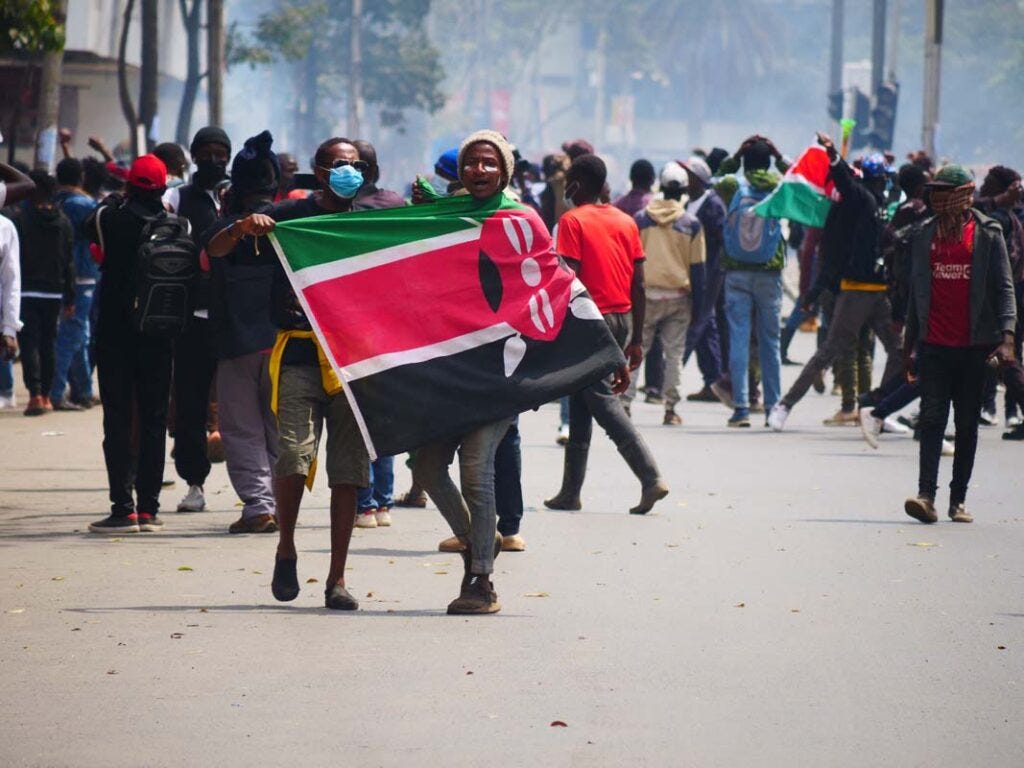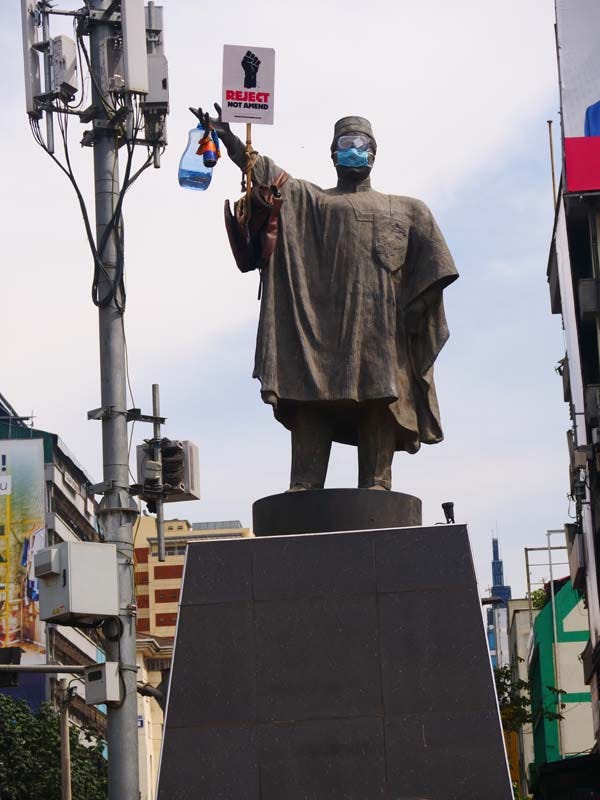The Gen-Z Awakening: Dismantling Kenya's Tribal Politics in the Shadow of Sessional Paper No. 10
Redefining Kenya's Political Future Beyond Tribal Legacies

In the heart of Nairobi, where the echoes of colonial rule still linger in the corridors of power, a new force has emerged. The Gen-Z movement, born in the digital age and unburdened by the tribal divisions of the past, has taken to the streets in a display of unity that has shaken the very foundations of Kenyan politics. At the center of their protest lies the contentious 2024-25 Finance Bill, a document that threatens to strain the already beleaguered Kenyan citizens further. But beneath this immediate catalyst churns a deeper current of discontent, one that traces its origins back to a pivotal moment in Kenya's history: the Sessional Paper No. 10 of 1965.
To understand the significance of the current protests, we must first delve into the past. The Sessional Paper No. 10, titled "African Socialism and its Application to Planning in Kenya," was a foundational document that shaped the country's post-independence trajectory. On the surface, it espoused principles of equality and national unity. However, its implementation led to the entrenchment of tribal politics and economic disparities that continue to plague Kenya to this day.
The paper, while theoretically promoting equitable development, inadvertently reinforced regional and tribal identities. It advocated for a form of "African Socialism" that, in practice, concentrated power and resources in the hands of a political elite largely drawn from specific ethnic groups. This approach, which came to be known as "KANUISM" after the ruling Kenya African National Union party, effectively institutionalized tribal politics as a means of maintaining power.
Across the nation, the European invasion was met with massive defeat as Kenyans refused to be dominated. This was a defining moment for the country. Kenya's gaining independence meant a lot of things. It was envisaged that Uhuru would deliver Kenyans from hell to heaven on earth. But all of a sudden, tribal politics started drawing lines where none existed in such a closely linked community, but Kenya's politics by design was always meant to be tribal.
Tribalism in Kenya is not a historical avoidance. It can be traced to ancient hatred or warfare from cultures clashing over the ages. In fact, the primary opposing groups, the Westerners (Luo, Luhya, Kalenjin, Kisii) of western Kenya and the GEMA (Kikuyu, Embu, and Meru people) from the Mount Kenya area, had little contact with one another before the coming of the colonialists, while the pastoralists Kenyan Community were regarded as useless due to their minority numbers.
The politicization of ethnic identity in Kenya began much earlier. It started with the colonial experience. The British built a railway line in Kenya partly because they wanted to control the headwaters of the Nile because, at the time, they were in Egypt, which represented the shortest route to India during the Imperial Craft. The question now became how you make the railway line pay for itself.
In a nutshell, everything in Kenya was then focused along the railway line. This included schools, hospitals, and all sorts of infrastructure built 240 kilometers away from the railway line. This led to a very significant geographical concentration of power; therefore, historically, the provincial headquarters of each province was located either along the railway line or within 22 kilometers away from the railway line.
What also that meant was that if you take a keen look at Kenya, identity tends to follow geography; thus, ethnic groups tend to occupy a particular territory. Therefore, what transpired in Kenya was that the ethnic groups that were located 240 kilometers from the railway line (Mt. Kenya Communities, Rift Valley Communities, Luhyas, Luos, Kisiis) were, in addition, inserted into the colonial economy very early on hence, we had a geographically concentrated state, and an ethnically concentrated state.
Jomo Kenyatta- Kenya's founding father, had the opportunity to put to a halt the politicization of ethnic identity in the country instead of perpetuating it. Still, he nonetheless lost that very chance because he and the people around him believed that the way to retain power was to manipulate ethnic identity so that members of a particular identity would protect his vested interest.
At independence, Kenya decided to adopt the Sessional Paper NO.10 (African Socialism and its Application to Planning), and the government declared that its resources would be invested in areas with the highest returns. This, by and large, meant the same regions the colonial government had invested in, the areas within the railway line, and the primary beneficiaries were the communities that lived along the railway line. This explains why national schools, major roads, and infrastructures are within the railway line. However, the question that stands is where exactly the pastoralists are.
Historically, the pastoralists are very difficult to repress, and always have been, because they do not occupy territory. The territory is essential to repression, that is why farmers are so easy to repress. Consequently, the population of the pastoralist community keeps shifting, and thus this challenges the state.
What the colonial government did was ignore them by putting an institutional and legal barrier called the Special District Administration Act, which basically said that the pastoralist's communities were restricted from the central area; thus, the pastoralists' area was considered useless in Kenya (Any region very far from the railway line), and the regions along the railway line were regarded as helpful Kenya (240KM from the railway line).
This is how the politics of Kenya was shaped. This is due to the fact that the railway zone became the playing field of Kenya's politics. This was orchestrated in the sense that if a candidate wanted to win a Presidential election, they would mobilize more prominent communities within the railway zone. Still, not the Kikuyus for historical reasons, plus some smaller communities, and then the pastoralist communities would fill in.
Fast forward to 2024, and the specter of KANUISM still looms large over Kenyan politics. The proposed Finance Bill, with its sweeping tax increases, is seen by many as yet another tool wielded by the political elite to extract wealth from ordinary citizens while failing to address systemic corruption and mismanagement. It is against this backdrop that the Gen-Z movement has emerged, presenting a stark contrast to the divided politics of the past.
The leaderless, tribeless nature of the Gen-Z protests represents a direct challenge to the tribal political model that has dominated Kenya since independence. These young Kenyans, born into a globalized, interconnected world, reject the notion that ethnic affiliations should define their identities and interests. Instead, they rally around shared economic concerns and a vision of a more equitable Kenya.
This shift in political consciousness can be understood through the lens of social entropy, a concept borrowed from thermodynamics and applied to social systems. In this context, social entropy refers to the tendency of a society to move towards a state of more significant disorder or randomness over time. The tribal political system established by the Sessional Paper No. 10 can be seen as an attempt to impose order and control on Kenyan society. However, as with any closed system, entropy inevitably increases.
The Gen-Z movement represents this increase in social entropy. By rejecting tribal affiliations and embracing a more fluid, inclusive identity, these young Kenyans are dismantling the artificial order imposed by the post-independence political establishment. Their protests are not just about the Finance Bill; they are a manifestation of a society in flux, moving towards a new equilibrium that challenges the old power structures.
However, this path has its challenges. The Gen-Z movement finds itself on a collision course with deeply entrenched interests. They have opened multiple battle fronts simultaneously: against President William Ruto's government, which they view as incompetent and out of touch; against a politicized church that they see as complicit in maintaining the status quo; and against Members of Parliament who they believe have failed to represent their interests.
This multi-pronged approach reflects a sophisticated understanding of the interconnected nature of Kenya's political challenges. The movement recognizes that meaningful change cannot be achieved by targeting a single institution or individual. Instead, they seek to dismantle the entire system that has allowed tribal politics and corruption to flourish.
The intellectual focus of the Gen-Z movement stands in stark contrast to the "Black Rule on behalf of Whites" that characterized the post-independence era. This phrase, often used to describe the continuation of colonial-era exploitation under African leadership, aptly captures the essence of KANUISM. The Gen-Z movement seeks to break this cycle by fostering a new political consciousness that transcends both tribal and racial divisions. KANUISM has not disappeared; it has merely adapted. The tribal politics of the past have morphed into more subtle forms of ethnic favoritism and clientelism. However, the Gen-Z movement's rejection of tribal identities makes these tactics less effective, forcing the political establishment to confront a new reality.
The current protests are not without historical precedent. Kenya has a rich history of resistance, from the Mau Mau uprising against British colonial rule to the pro-democracy movements of the 1990s. However, these struggles have often been marred by betrayal and co-option. The Mau Mau fighters, for instance, found themselves marginalized in post-independence Kenya, their sacrifices forgotten by a political elite more interested in consolidating power than fulfilling revolutionary promises. The Gen-Z movement seems acutely aware of this history of betrayal. Their leaderless structure and emphasis on collective action are, in part, safeguards against co-option. By refusing to elevate individual leaders who could be bought off or intimidated, they hope to maintain the integrity of their movement.

The Finance Bill of 2024 may prove to be a catalyst for increased political engagement among Kenyan youth. Historically, voter apathy has been a significant challenge, with many young people feeling disconnected from a political process they see as corrupt and unresponsive. However, the tangible impact of the proposed tax increases on their daily lives has galvanized many previously disengaged youth. The Gen-Z movement has skillfully channeled this anger into sustained political action, potentially laying the groundwork for higher youth turnout in future elections.
As we look to the future, the question becomes: how can this movement create a new Kenya? The answer lies in their ability to translate protest energy into lasting institutional change. This will require not just the dismantling of old structures but the creation of new ones that embody the principles of inclusivity, accountability, and equity that the movement champions.
The road ahead is undoubtedly challenging. Entrenched interests will not yield power quickly, and the temptation of tribal politics remains vital for many. However, the energy, creativity, and determination displayed by the Gen-Z movement offer hope for a new Kenya. A Kenya where identity is defined not by tribe or race, but by shared values and aspirations. A Kenya where the promises of independence are finally fulfilled, not through the perpetuation of colonial-era exploitation, but through genuine empowerment of all citizens.
As this movement continues to evolve, it carries with it the hopes of a nation long divided. In the streets of Nairobi and beyond, a new generation is rising, armed not with weapons but with ideas. They seek not to replicate the revolutions of the past but to forge a uniquely Kenyan path to justice and prosperity. In doing so, they may finally break free from the long shadow cast by the Sessional Paper No. 10, ushering in an era of true African socialism that serves all Kenyans, not just a privileged few.




